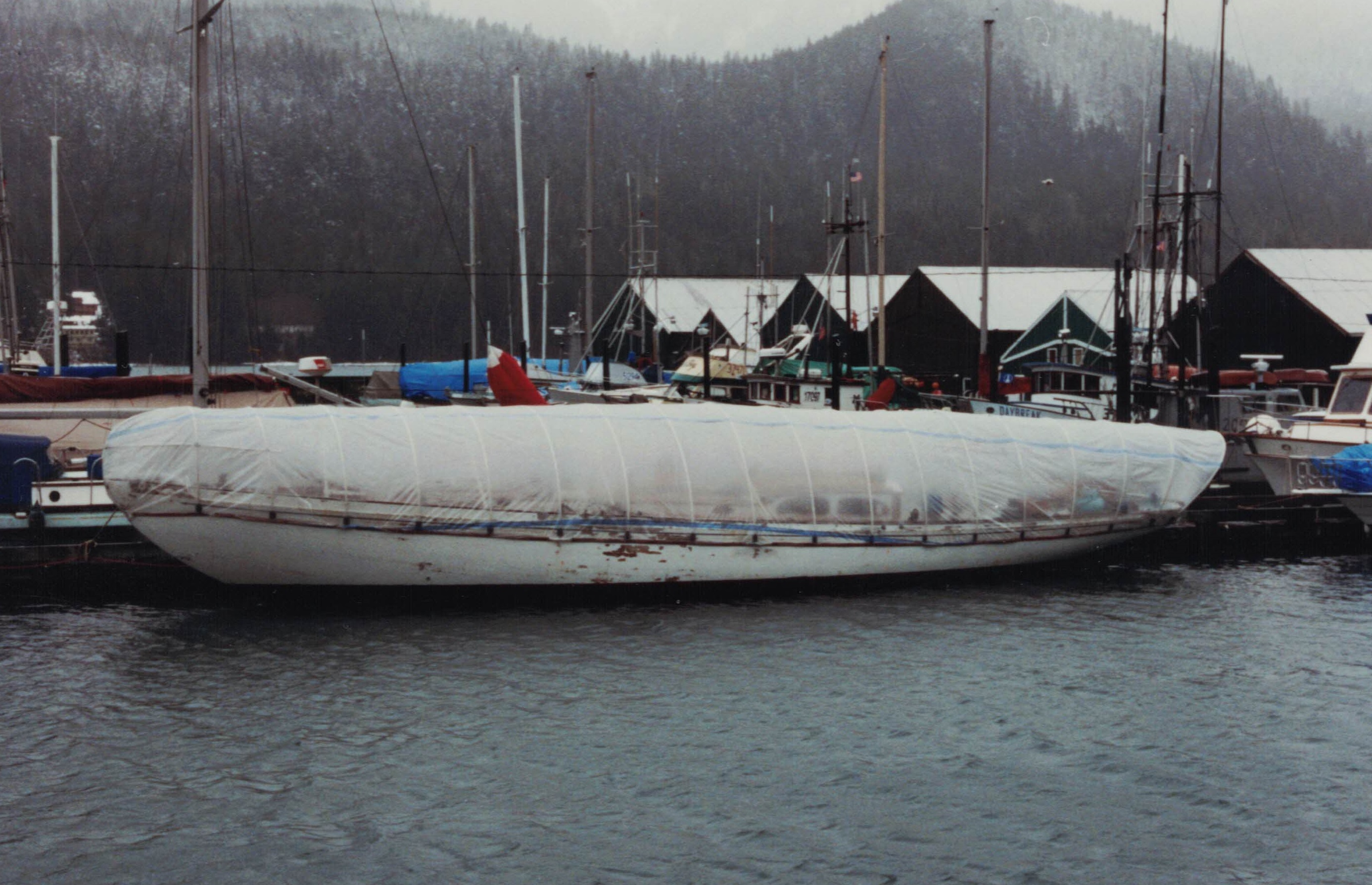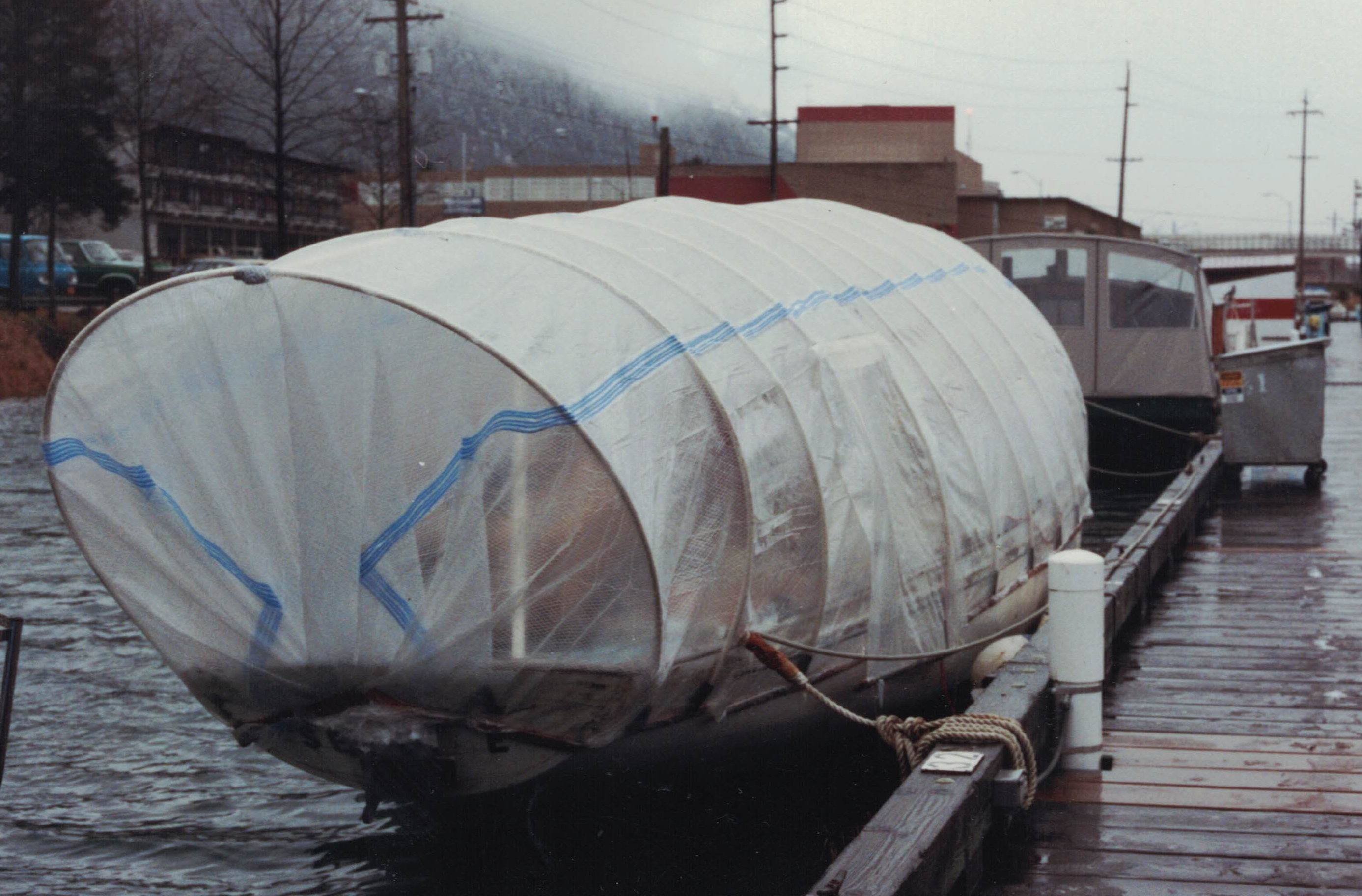It was obvious that the project we had on our hands was going to take longer than a haul out in the yard would accommodate. Wooden boats don’t like to be out of the water anyway, so we needed a plan that would keep her in the water. Working on the deck 15-feet up isn’t all that pleasant and we needed to figure out how to keep the weather off.

The above photo is version 1.0 of this cover. Leda would remain under a similar cover for the next six years. The original cover seen above was made with PVC pipe socketed into fittings that were screwed to Leda’s hull. The plastic sheathing is reinforced contractors plastic. A fan was placed forward to vent air out of the structure. This helped to keep it dry inside and to remove heat during summer months.
It was somewhere early in this process that we met Peter Reece of KZ Boatbuilding. We were visiting family in Oregon and I picked up some kind of weekly newspaper. There was an ad in it for KZ Boatbuilding, located in Vancouver, Washington, across the river from Portland. I got in touch with Peter which produced two important results.
One such result was that Peter knew of which magazines in New Zealand would be good to use to solicit information about our boat. So he placed an ad in one giving my name and address with a request for any information or history. I started getting letters from NZ. I got so many that it took me a year to answer them all. But answer them all I did. One such letter was from Dooley Wilson and another was from Erica Wilson. I’d made contact with Leda’s past.
The other important result was that Peter traveled to Juneau to have a look at the project. The intent was that we might hire him to do some of the work. What I got instead was a lot of really good advice. I’ll never forget Peter telling me that “you can’t buy the kind of work you will do for yourself”. I don’t know now whether I had started stripping stuff off the boat or exactly what the boat looked like when he showed up. But we spent a lot of time talking about the project and coming up with a plan. It was decided by both of us that I couldn’t hire Peter to do this job. It was cost prohibitive for me and for Peter, he didn’t want to move to Alaska!

As we progress through the description of the work that was done, you will see variations on the theme of the boat cover. Some ideas worked better than others. Eventually I started putting a new outside skin on as needed and taking the old one and putting it up on the inside so that I had a double skin. It kept the condensation down and improved my ability to keep it warm inside. The fan stayed, it was a life saver. Our motto in those days was, “Preservation, Restoration, take a vacation”. It had become clear that if steps were not taken to preserve what we had that a restoration was impossible.
In 1992 you did not see these kind of structures on boats. Usually they would have been wood framed and covered in blue tarps. My first job when I got out of high school had been building big top tents. I learned things there that have served well in many applications and I employed those skills here. It wasn’t long before you saw these kinds of structures springing up on boats everywhere. I’d like to think I started the fad, but in truth I think it was an idea whose time had come. Price and availability of the plastics used for this had gotten to the point where lots of people saw the potential. If you want to give me credit, I won’t mind, I’ve got an ego to feed too, but I hate lying to myself despite getting away with it often enough.
The plastic has a nylon reinforcing grid in a diamond shape. By now I suppose everyone has seen it. In those days I had to give my wife directions to a place in S.W. Portland, Oregon to buy it so that she could ship it home to me. I no longer remember how I became aware of it, but I do remember thinking what brilliant stuff it was when I saw it. And it is. It has enough stretch to form when you put tension on it. It lets through lots of light and it takes a beating. I was able to glue a sleeve on the side of it so that my fan would not let in rain, so I had a tube on the side of the boat looking like those advertising atrocities that car lots seem to be fond of.
The only problem with this early version was that I had used too small of a diameter of PVC pipe. I over estimated its ability to shed snow and I found the top crushed down to the cabin top on a few occasions. Later editions used heavier pipe and did a much better job of shedding snow. Later versions still got pushed to the deck once in a while, it just took more snow to do it. So the process was to get there early during large snow events to keep the snow off. Otherwise it was necessary to scrape off as much as possible, then squeeze under and start pushing. When I built my brackets to mount on the side of the boat I made them as sockets. They should have been made male instead of female. As when I moved to a larger diameter pipe it would not fit. So I rigged up some pieces of rebar (reinforcing bar for use in concrete construction) to adapt to my sockets. The first time I put the top together with this configuration I launched one of these pieces of steel catapult style while trying to bend the pipe down into place. The thing took off flying. I physically cringed but was relieved when I heard it splash into the water instead of hitting another boat! As a result later evolutions included methods to avoid this.
Next: The Plan Emerges
Previous: What To Do?